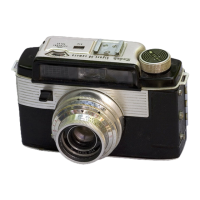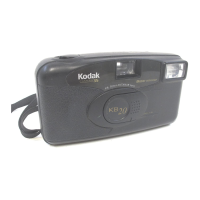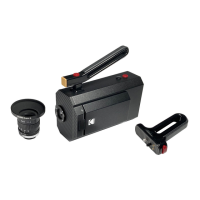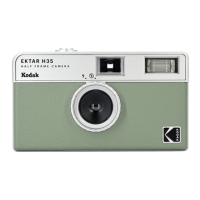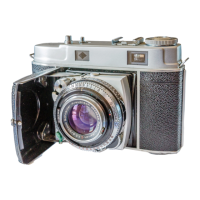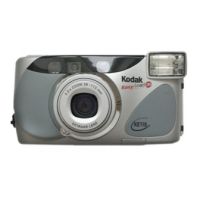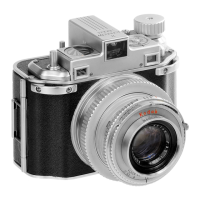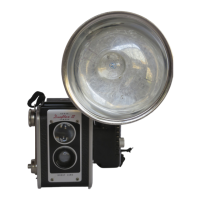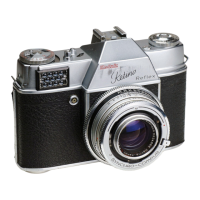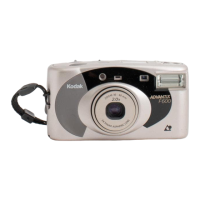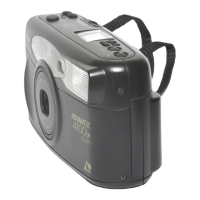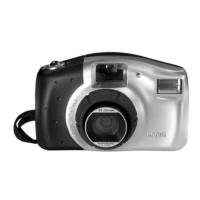Do you have a question about the Kodak SPECIAL and is the answer not in the manual?
Explains how to swap film chambers for different film types or continuous shooting.
Detailed steps and illustrations on safely detaching the film chamber from the camera body.
Instructions for correctly reattaching a film chamber to the camera, ensuring proper engagement.
Describes the function and operation of the aperture cover button to protect film from light.
Step-by-step guide on loading film into the 100-foot and 200-foot film chambers.
Procedure for running off the film leader before the main film is exposed.
Instructions for safely unloading exposed film from the camera in daylight conditions.
Simplified guide for basic filming, covering winding and basic exposure settings.
Guidance on setting the speed dial and shutter lever for hand-held operation.
Emphasizes the importance of camera stability for picture quality.
Explains the buzzing sound indicating the shutter is closed and how to resolve it.
Details the eye-level finder, its components, and proper use for framing shots.
Covers how camera speed and diaphragm settings affect film density and image brightness.
Explains sharpness, focusing methods, and the concept of depth of focus with different lenses.
Provides tips on composition, handling water drops, and panning techniques.
Lists key operational guidelines and safety precautions for using the camera.
Describes the function of the turret head for quick lens changes.
Details which lenses can be mounted together on the turret and potential interferences.
Explains how lens speed is designated by aperture and focal length.
Outlines the applications and characteristics of different focal length lenses.
Explains how camera speed affects action portrayal and exposure.
Details the function and uses of the variable shutter for exposure control and effects.
Describes the use of masks for creating special picture shapes like oval and round.
Describes the tripod truck for stable camera mounting and movement.
Explains the reflex finder's value for accurate focusing and parallax correction.
Details the magnifier attachment to simplify focusing and framing with the reflex finder.
Instructions on creating fade-in and fade-out effects using the shutter lever.
Guidance on creating smooth transitions between scenes by overlapping fades.
Instructions for using the single frame release for animation and stop-motion work.
Describes the one-frame shaft for prolonging exposure or precise frame movement.
Explains the function and use of the frame counter for precise exposure tracking.
Details how to achieve double exposures using half-masks for creative effects.
Procedure for safely running down the camera's spring motor.
How to operate the camera manually when the motor run is insufficient.
Describes the characteristics and benefits of this black-and-white film type.
Explains the advantages of this faster film for low-light conditions.
General purpose film for occasions where specialized films are not needed.
Details the process of making color movies with Kodachrome film.
Explains the use of Ciné-Kodak Color Filters for black-and-white and color photography.
Provides exposure factors for using the CK-3 filter with different film types.
Lists specific filter mounts and their compatibility with various lenses.
Refers to additional information on filters for Kodachrome film.
Discusses different types of artificial lights and their use with the camera.
Technique for making objects or people gradually disappear from a scene.
Method for creating transparent or "ghostly" figures in film scenes.
Techniques for creating industrial or mechanical "X-Ray" style shots.
Details how to achieve double exposures using half-masks for creative effects.
Details how to expose the same film strip multiple times for various visual effects.
Guide to creating animated sequences by exposing single frames of moving objects.
How to achieve slow or fast motion effects by adjusting frame exposure frequency.
Describes the "wipe" transition effect created by progressively blocking the camera's view.
Instructions for cleaning the pressure plate, aperture plate, and guide for optimal performance.
Guidance on maintaining lens cleanliness for sharp, high-contrast images.
Steps for cleaning the reflex finder's magnifier and ground glass for accurate focusing.
Procedures for lubricating the camera mechanism with specified oil for smooth operation.
Information on ordering custom text titles for films, with pricing.
Describes scroll-style titles that move upward, including ordering details.
Details on ordering color titles specifically designed for Kodachrome film.
Information on obtaining copies or duplicates of existing film footage.
Service for making film copies of still photographs or drawings.
Information on additional lenses for achieving field sizes larger than standard.
Details on a filter holder system that fits various lenses and filter types.
Explains how to swap film chambers for different film types or continuous shooting.
Detailed steps and illustrations on safely detaching the film chamber from the camera body.
Instructions for correctly reattaching a film chamber to the camera, ensuring proper engagement.
Describes the function and operation of the aperture cover button to protect film from light.
Step-by-step guide on loading film into the 100-foot and 200-foot film chambers.
Procedure for running off the film leader before the main film is exposed.
Instructions for safely unloading exposed film from the camera in daylight conditions.
Simplified guide for basic filming, covering winding and basic exposure settings.
Guidance on setting the speed dial and shutter lever for hand-held operation.
Emphasizes the importance of camera stability for picture quality.
Explains the buzzing sound indicating the shutter is closed and how to resolve it.
Details the eye-level finder, its components, and proper use for framing shots.
Covers how camera speed and diaphragm settings affect film density and image brightness.
Explains sharpness, focusing methods, and the concept of depth of focus with different lenses.
Provides tips on composition, handling water drops, and panning techniques.
Lists key operational guidelines and safety precautions for using the camera.
Describes the function of the turret head for quick lens changes.
Details which lenses can be mounted together on the turret and potential interferences.
Explains how lens speed is designated by aperture and focal length.
Outlines the applications and characteristics of different focal length lenses.
Explains how camera speed affects action portrayal and exposure.
Details the function and uses of the variable shutter for exposure control and effects.
Describes the use of masks for creating special picture shapes like oval and round.
Describes the tripod truck for stable camera mounting and movement.
Explains the reflex finder's value for accurate focusing and parallax correction.
Details the magnifier attachment to simplify focusing and framing with the reflex finder.
Instructions on creating fade-in and fade-out effects using the shutter lever.
Guidance on creating smooth transitions between scenes by overlapping fades.
Instructions for using the single frame release for animation and stop-motion work.
Describes the one-frame shaft for prolonging exposure or precise frame movement.
Explains the function and use of the frame counter for precise exposure tracking.
Details how to achieve double exposures using half-masks for creative effects.
Procedure for safely running down the camera's spring motor.
How to operate the camera manually when the motor run is insufficient.
Describes the characteristics and benefits of this black-and-white film type.
Explains the advantages of this faster film for low-light conditions.
General purpose film for occasions where specialized films are not needed.
Details the process of making color movies with Kodachrome film.
Explains the use of Ciné-Kodak Color Filters for black-and-white and color photography.
Provides exposure factors for using the CK-3 filter with different film types.
Lists specific filter mounts and their compatibility with various lenses.
Refers to additional information on filters for Kodachrome film.
Discusses different types of artificial lights and their use with the camera.
Technique for making objects or people gradually disappear from a scene.
Method for creating transparent or "ghostly" figures in film scenes.
Techniques for creating industrial or mechanical "X-Ray" style shots.
Details how to achieve double exposures using half-masks for creative effects.
Details how to expose the same film strip multiple times for various visual effects.
Guide to creating animated sequences by exposing single frames of moving objects.
How to achieve slow or fast motion effects by adjusting frame exposure frequency.
Describes the "wipe" transition effect created by progressively blocking the camera's view.
Instructions for cleaning the pressure plate, aperture plate, and guide for optimal performance.
Guidance on maintaining lens cleanliness for sharp, high-contrast images.
Steps for cleaning the reflex finder's magnifier and ground glass for accurate focusing.
Procedures for lubricating the camera mechanism with specified oil for smooth operation.
Information on ordering custom text titles for films, with pricing.
Describes scroll-style titles that move upward, including ordering details.
Details on ordering color titles specifically designed for Kodachrome film.
Information on obtaining copies or duplicates of existing film footage.
Service for making film copies of still photographs or drawings.
Information on additional lenses for achieving field sizes larger than standard.
Details on a filter holder system that fits various lenses and filter types.
| Film Format | 35mm |
|---|---|
| Image Size | 24 x 36mm |
| Type | Rangefinder camera |
| Film Type | 35mm |
| Focus | Manual |
| Viewfinder | Optical rangefinder |
| Aperture | f/3.5 - f/16 |
